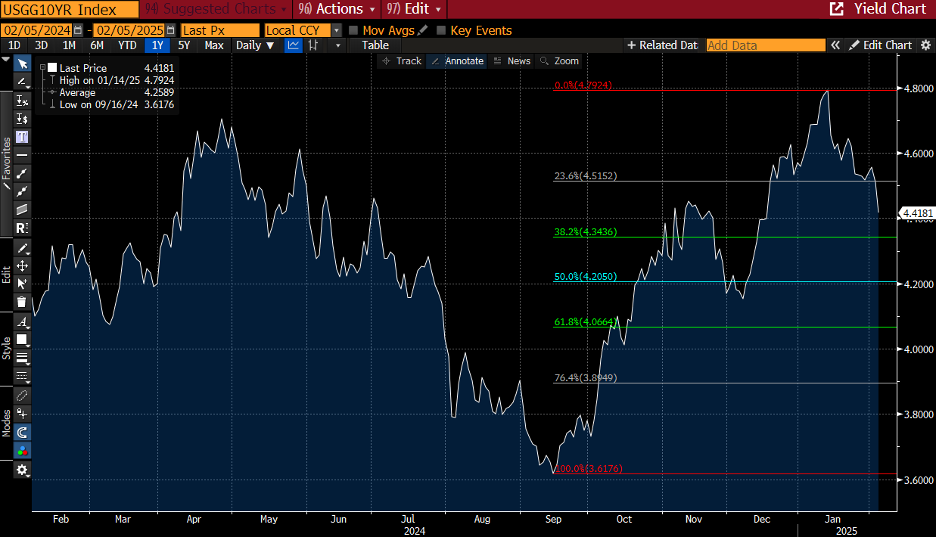THIS IS NOT INVESTMENT ADVICE. INVESTING IS RISKY AND OFTEN PAINFUL. DO YOUR OWN RESEARCH.
There was a stack of Australian pound notes scattered sloppily and extravagantly under his crossed legs, and while he felt it was bad luck to count his money, he knew he must have won nearly a hundred pounds. It gave him a thick lustful sensation in his throat, the kind of excitement he received from any form of abundance.
The Naked and the Dead, Norman Mailer, 1948
Trump is seeking to move fast enough that the law can’t constrain him. The question is if markets will. If he listens to markets, this limits scope for action. If he doesn’t, markets can crash violently.
Consider how stocks and bonds responded to tariffs. The initial narrative, which lasted until just before the inauguration, was that Trump would engineer a tax cut, expanding a 6% budget deficit. That along with inflation worries drove bond yields up 120 basis points (from 3.6% to 4.8%). The number may seem small, but it is enough to constrain private-sector borrowing. But since just before the inauguration, bond yields descended and this rapidly accelerated after Trump threatened tariffs.
Bond yields rose because the market thought he’d cut taxes. Tariffs are raising taxes, which is bad for growth, so interest rates fell. The point is—in a world where opposite ideological camps can’t agree on basic facts, financial markets offer a more objective lens. Further confirmation tariffs are viewed as bad for growth is the shape of the yield curve. Long-term bond yields fell relative to short-term bond yields, something only bond geeks pay attention to. In the equity markets, it was more obvious—a big puke when tariffs were announced and then a rally when Trump relented.
The tariff whiplash plus a flurry of other announcements on Gaza, Greenland, the FBI, CIA, and USAID obscures the broader plan. The goal is to overwhelm the skeptical with a flurry of activity. If you step back, the vision isn’t that complicated—Trump and his backers want to revamp the US government the way a start-up revamps an existing business, call it techno-authoritarianism.
Techno Authoritarianism
Trump and his acolytes have more hinted at their plan than spelled it out. It’s not authoritarianism like what we read about in the first half of the 20th century. Nor is it like Singapore’s Lee Kuan Yew authoritarianism, who was rigidly rule-following. Instead, it is more improvisational, an odd amalgam of Trump’s need to be the center of attention and break norms, the proclivities and interests of his financial backers, and the support this is generating from wide swathes of society deeply frustrated by a combination of low real wages, political correctness, and disruptive change.
Wealth is created via this very disruption, or creative destruction, a term coined by Harvard economist Joseph Schumpeter after WWII. The most recent wave of such innovation has created unprecedented economies of scale. The winners seem to have developed a confidence the process by which they obtained that wealth is a magical elixir that needs to be more broadly applied. Government is the perfect laboratory for that and also, of course, can help their business, a virtuous circle.
Amazon is Sears Roebuck on the web. Uber turns the local driver into a yellow car. Tesla is Ford with a battery. The new company is built from scratch, obliterating the old. The ingredients are a fearless, all-powerful, willful leader, cutting-edge tech, cheap financing (requiring a healthy equity market) and rule of law to protect the intellectual property behind the innovation. This model is being applied to government. A key feature is to give Trump the same power as a CEO. In a rule of law system, Congress allocates funding. In this system, Elon has a say. The structural flaw in authoritarianism is that the King can veer wildly off course. We all know the most egregious political examples of this. In market terms, it is the difference between Enron and Apple. Trump’s backers think such concerns are overwrought.
They are effectively willing to tolerate lawlessness or in their minds, creative destruction, to achieve radical change. Unlike in Maoist China, however, Trump’s backers are beholden to the stock market. I suspect the 3%+ decline in stock markets Sunday night may have been persuasive in getting Trump to back off tariffs. Similarly, Tesla’s stock has fallen over 20% from its post-election highs The market might be saying—'Elon, get back to work.’
From here, the next big hurdle is the budget and negotiations with China. So far Congress has been toothless, approving virtually all of Trump’s ideas. That sets up a tax cut without meaningful offsets, which might then weigh once again on long-term bond yields and create the next chapter in this story. Or it could be that there are more meaningful spending cuts. More boldly, if Trump were to fashion a trade deal with China, this would be against all expectations and lead to a potentially explosive rise in both foreign stock markets and US bond yields. We are right on the edge of chaos. I hope we don’t tip over the edge, that limits are pushed but not breached, but open to the notion we will.








The phrase "old world disorder" or "new world order" keeps going through my mind. But we live in an upside down world. Maybe it's now a new world disorder or an old world new order. Instead of peace through strength maybe we'll get war through weakness. The future does not belong to the faint hearted, so said Reagan. But .maybe the past does not belong to anyone either.
Brilliant Paul! Your mind is so sharp. Across countries and cultures, I hope one is able to recognize, no, just acknowledge, that great discussions are productive. Thanks!